Results 2,921 to 2,930 of 12096
Thread: Anandtech News
-
05-23-13, 05:01 AM #2921
Anandtech: AMD’s 2013 Elite Mobility Platform, aka Temash
AMD has a bunch of APUs launching today, and while the only hardware we have on hand for testing right now consists of a Kabini laptop, we wanted to at least briefly discuss the two other APUs. Temash is essentially the same APU as Kabini, only with a lower TDP target, which also means reduced clock speeds. Where Kabini is destined for ultraportable laptops and hybrid devices, or perhaps a larger tablet, Temash is very much targeted at “true” tablets. The Temash family currently consists of three APUs with three different TDPs:
At the top of the product stack is the A6-1450, a true quad-core APU with a 1.4GHz maximum Turbo Core clock and a base 1.0GHz clock. It has an 8W TDP, and like all of the currently announced Kabini/Temash parts it features a GCN-based GPU with 128 Radeon cores. Clock speeds on both the CPU and GPU are lower than the A4-5000M Kabini we looked at today, but in the world of tablets the A6-1450 should prove quite formidable. What’s interesting (or perhaps “odd” is a better word) is that the A6-1450 has a lower TDP than the next APU, the A4-1250.
The A4-1250 drops to a dual-core CPU and skips out on Turbo Core. With those two changes, one would expect it to consume less power than the A6 model, but it ends up at the same 8W. (Note: I have another slide from AMD that shows 9W; this might simply be a typo, but the above slide shows 8W.) That could mean the A4-1250 is either die-harvested or, more likely, it’s from a part of the wafer that wasn’t able to reach the TDP/clock speed requirements to be in a lower power part. I’d guess that the A4-1250 shouldn't have to throttle much, but we'll see.
The final chip is the same configuration as the A4-1250, but the A4-1200 has a reduced GPU clock and it has a 3.9W TDP. This is the chip that will go up against the current fastest ARM SoCs like Apple’s A6 in the 4th generation iPad 4 and Qualcomm’s Krait. Based on what we’ve seen from Kabini, at 225MHz the A4-1200 should be roughly comparable to the A6 GPU, though Apple has of course been shipping for a while now whereas we’ve yet to see a Temash tablet.
AMD provided the usual collection of marketing material, which we’ve included in the gallery below.
Gallery: AMD’s 2013 Elite Mobility Platform, aka Temash





More...
-
05-23-13, 05:30 AM #2922
Anandtech: AMD’s 2013 Elite Mobility Platform, aka Temash
AMD has a bunch of APUs launching today, and while the only hardware we have on hand for testing right now consists of a Kabini laptop, we wanted to at least briefly discuss the two other APUs. Temash is essentially the same APU as Kabini, only with a lower TDP target, which also means reduced clock speeds. Where Kabini is destined for ultraportable laptops and hybrid devices, or perhaps a larger tablet, Temash is very much targeted at “true” tablets. The Temash family currently consists of three APUs with three different TDPs:
At the top of the product stack is the A6-1450, a true quad-core APU with a 1.4GHz maximum Turbo Core clock and a base 1.0GHz clock. It has an 8W TDP, and like all of the currently announced Kabini/Temash parts it features a GCN-based GPU with 128 Radeon cores. Clock speeds on both the CPU and GPU are lower than the A4-5000M Kabini we looked at today, but in the world of tablets the A6-1450 should prove quite formidable. What’s interesting (or perhaps “odd” is a better word) is that the A6-1450 may have a lower TDP than the next APU, the A4-1250.
The A4-1250 drops to a dual-core CPU and skips out on Turbo Core. With those two changes, one would expect it to consume less power than the A6 model, but it ends up at the same 8W. (Note: I have another slide from AMD that shows 9W; this might simply be a typo, but the above slide shows 8W.) That could mean the A4-1250 is either die-harvested or, more likely, it’s from a part of the wafer that wasn’t able to reach the TDP/clock speed requirements to be in a lower power part. I’d guess that the A4-1250 shouldn't have to throttle much, but we'll see.
The final chip is the same configuration as the A4-1250, but the A4-1200 has a reduced GPU clock and it has a 3.9W TDP. This is the chip that will go up against the current fastest ARM SoCs like Apple’s A6 in the 4th generation iPad 4 and Qualcomm’s Krait. Based on what we’ve seen from Kabini, at 225MHz the A4-1200 should be roughly comparable to the A6 GPU, though Apple has of course been shipping for a while now whereas we’ve yet to see a Temash tablet.
AMD provided the usual collection of marketing material, which we’ve included in the gallery below.
Gallery: AMD’s 2013 Elite Mobility Platform, aka Temash





More...
-
05-23-13, 08:30 AM #2923
Anandtech: NVIDIA GeForce GTX 780 Review: The New High End
Launching today is NVIDIA's latest entry in the world of high end video cards and the first member of the GeForce 700 family, the GeForce GTX 780. Based on the same GK110 GPU as GeForce GTX Titan, it stands to be a powerful card. But is the new high end going to make sense for everyone? We'll find out.
More...
-
05-23-13, 11:30 PM #2924
Anandtech: Mythlogic Callisto 1512 (Clevo W550EU) Ultrabook Review
Major OEMs are producing ultrabooks at a breakneck pace, but vendors like Clevo are making sure boutiques can get in on the market, too. Mythlogic sent us their Callisto 1512 based on the Clevo W550EU for testing.
More...
-
05-24-13, 01:00 PM #2925
Anandtech: The Kabini Deal: Can AMD Improve the Quality of Mainstream PCs with Its La
There are two non-negotiables in building a PC these days: the cost of Intel silicon and the cost of the Windows license. You can play with everything else but Intel and Microsoft are going to get their share. Those two relatively fixed costs in the PC bill of materials can do one of two things: encourage OEMs to skimp on component cost elsewhere, or drive the entire ecosystem to supply higher quality components at lower prices. If you’ve been following the PC industry for the past decade, I think we’ve seen more of the former and less of the latter.
Apple occupying the high-end of the notebook PC space has forced many OEMs to reconsider their approach, but that’s a more recent change. What AMD seems to offer is an easier path. AMD will take less of the BoM, allowing OEMs to invest those savings elsewhere - a move Intel will never make. Given how much pressure the PC OEMs have been under for the past few years, AMD’s bargain is more appealing now than it has ever been.
With Llano and Trinity, AMD’s story was about giving up CPU performance for GPU performance. With Kabini, the deal is more palatable. You only give up CPU performance compared to higher priced parts (you gain performance compared to Atom), and you get much lower power silicon that can run in thinner/lighter notebooks. Typically at the price points Kabini is targeting (sub-$400 notebooks), you don’t get pretty form factors with amazing battery life. AMD hopes to change that.
More...
-
-
05-28-13, 05:31 AM #2927
Anandtech: Nixeus NX-VUE30 30" : A $699 WQXGA (2560x1600) IPS LED Monitor
In August 2012, Nixeus launched the VUE27, a 27" WQHD (2560x1440) S-IPS LED monitor with a $430 price tag. By providing US-based service / warranty, they managed to win over quite a big segment of the market which was being served by eBay sellers based in Korea. In addition to undercutting the price, the Nixeus unit also provided a wider variety of input ports. Our review found it to be a very decent performer for the price.
This year, Nixeus is launching the 30" WQXGA (2560x1600) version with a similar range of input ports, based on a LG panel, as usual. However, the main competition this time around is from Monoprice, and not from the eBay sellers. Monoprice has been selling a 30" WQXGA monitor with HDMI and DP ports (in addition to the standard DL-DVI) for quite some time at a price point of approximately $800. Nixeus is planning to beat that by a full $100, pricing their offering at $699.
The claimed specifications of the NX-VUE30 are as below:
[LIST] [*] Display Size: 30" [*] Resolution: 2560*1600 [*] Aspect ratio: 16: 10 [*] Brightness: 350 cd/m2 [*] Contrast Ratio: 1000: 1 [*] Response Time: 7ms (Gray to Gray) [*] Viewing Angle: 178(H)178(V) [*] Display Color: 1.07 billion [*] Stereo Speakers [*] Connectivity: VGA, HDMI, DL-DVI, Display Port 1.2 [*] Power Power Consumption:
-
05-28-13, 07:31 AM #2928
Anandtech: Western Digital Launches WD Se Hard Drive Lineup for Datacenters and High-
One of the most interesting launches from Western Digital last year was the WD Red line of hard drives from the client storage division. It was intended for low to mid-range NAS units (and WD wanted to make sure that it wasn't used for units with more than 5 bays). Today, the Datacenter Storage Business Unit is launching the WD Se line intended for high end NAS units and, more importantly, datacenters looking for scalable storage (i.e, reliable storage which doesn't cost an arm and a leg for scenarios where capacity, rather than performance, is of primary importance).
The WD Se line consists of 3.5" 7200rpm Advanced Format SATA drives in 2 TB (WD2000F9YZ), 3 TB (WD3000F9YZ) and 4 TB (WD4000F9YZ) capacities. All of these units have a 64 MB buffer. Pricing ranging from $160 at the low end to $310 at the higher end. Like the WD Re (and, unlike the desktop variants), the WD Se line has a self-encryption option. These drives come with the five year enterprise warranty. Western Digital touts the usage of WD Se drives in their own datacenter (with Apache Hadoop).
WD also advocates use of the WD Se drives in NAS units with 6 to 24 bays in both the desktop as well as rackmount form factors as a complement to the WD Red drives in the lower end units. In the datacenter, WD suggests usage of the WD Re and WD Xe drives for higher durability and performance. Note that the suggested workload for the WD Se is only 180 TB/yr, compared to 550 TB/yr for the WD Re, suggesting that WD is positioning this drive as a solution for backups, archiving and other low intensity tasks. On a comparative basis, the WD Red apparently has a workload rating of less than 100 TB/yr (the client storage division doesn't give out specific numbers) despite coming with a higher MTBF rating (1M hours compared to the 800K for the WD Se).
Some of the features of WD Se include dual processors to maximize performance, RAFF (rotary acceleration feed forward) to monitor and correct vibrations in real time (an issue common in datacenter environments), dual actuator technology to improve positional accuracy of the heads, StableTrac motor shaft securing at both ends to minimize vibrations, multi-axis shocks sensors, RAID-specific TLER (which we covered in the WD Red review) and dynamic fly height technology.
More...
-
05-28-13, 08:00 AM #2929
Anandtech: Synology Launches DS1813+ Quad-GbE 8-bay NAS
A few weeks back, we had the launch of the DS1513+ 5-bay NAS from Synology. Today, we have the follow-up product in the 8-bay DS1813+. Similar to the DS1513+, we have four GbE ports in the new unit. The base platform remains the same (a 2.13 GHz Atom D2700 CPU and 2 GB of RAM, with the memory being upgradeable to 3 GB).
Gallery: Synology DS1813+_thumb.png)
_thumb.png)
_thumb.png)
_thumb.png)
_thumb.png)
_thumb.png)
With all four links aggregated, Synology claims up to 350 MBps reads and 200 MBps writes. This is the same as what was claimed for the DS1513+. Other features available in the DS1513+ (such as Synology High Availability, screwless drive bays etc.) are also available in this new unit.
The total capacity can be extended from 8-bays to 18-bays using two DX513 expansion units. This unit is quite attractive to consumers looking for a 8-bay unit, with the only obvious issue being lackluster encryption performance (the Atom D2700 doesn't have the AES-NI feature to accelerate encrypted volume performance).
The unit is now shipping globally, though availability may vary by region. Going by what the DS1812+ was launched at, this unit can be expected to cost slightly north of $1000.
More...
-
05-28-13, 09:30 AM #2930
Anandtech: NVIDIA GeForce GTX 780 Overclocking Results
Although we didn’t have enough time to include our GeForce GTX 780 overclocking results in our review of NVIDIA’s latest card, we didn’t want to discard them entirely. Especially not after seeing just how far GTX 780 could overclock. So as an addendum to last week’s review, let’s take a look at GTX 780 overclocking.
When it comes to overclocking, GTX 780 is in an interesting spot. On the one hand it’s already the highest clocked GK110 part, with a base clock of 863MHz, making it the GK110 part closest to any practical clockspeed limits. On the other hand GTX 780 is built against the same power delivery requirements as GTX Titan, with a stock TDP limit of 250W. This is significant because GTX 780 pacls a GPU with fewer enabled SMXes than GTX Titan, and perhaps more importantly half as many RAM chips.
So while GTX 780 can’t necessarily clock any higher than GTX Titan, the additional TDP headroom means that it’s more likely to reach its higher boost bins more often, making overclocking more effective. Amplifying all of this is the fact that at stock GTX 780 is more often temperature limited than it is TDP limited, amplifying the factor we have the greatest control over (the temperature throttle) and minimizing the factor we have the least control over (the TDP limit).
The end result is that while the GTX 780 isn’t going to be an overclocking champion, it’s in a good position to satisfy overclockers. On our sample we’ve been able to push it ahead by 200MHz, moving the base clock from 863MHz to 1063MHz, a 23% improvement. Meanwhile on the memory side NVIDIA’s solid memory controller implementation once more shines through, with our sample easily going from a 6GHz memory clock to a 7GHz memory clock, a 1GHz (17%) improvement.GeForce GTX 780 Overclocking Stock Overclocked Core Clock 863MHz 1063MHz Boost Clock 902MHz 1102MHz Max Boost Clock 1006MHz 1228MHz Memory Clock 6GHz 7GHz Max Voltage 1.162v 1.2v
And what do we get for our efforts? In short, thanks to the fact that GTX Titan is only 11% faster than GTX 780 on average in the first place, GTX 780 can easily exceed Titan’s stock performance when overclocked. Actual scaling depends on the game – not every game scales well with higher clockspeeds alone – but in most games we at least pick up the 17% lower bound that comes with the memory overclock. This means that an overclocked GTX 780 crosses those few 60fps thresholds that the stock GTX 780 fell just shy of, including the minimum framerate in HItman: Absolution, and the average framerate in Crysis 3.
One of the more pronounced outcomes of overclocking the GTX 780 is that we’re essentially exchanging the card’s temperature limit for its TDP limit. Being temperature limited keeps fan speeds down and reduces leakage, but it’s also a limit we have a great deal of control over. Whereas with the TDP limit we can only raise it by 6%, from 250W to 265W, which is immediately consumed by a combination of higher boost bins, higher again boost bins from overvolting, and slightly increased leakage. The end result is that the TDP limit places a rather hard cap on performance, although the ultimate performance limit remains untouched since we can’t completely discard power for performance, leaving the highest boost bins underutilized.
Because GTX 780 is more often temperature limited, and hence running under its TDP, overclocking does come with some pretty stiff consequences for power consumption. Power consumption under FurMark only rises by 6W at the wall since it’s already TDP limited, but in BF3 the difference is 55W at the wall. Some of that is due to higher CPU power consumption as the CPU is tasked with generating more frames, but most of that is from GTX 780 itself. As we saw earlier the performance increase is quite good, but accessing it does mean giving up the GTX 780’s finely honed performance/power ratio.
As for load temperatures, these top out at 84C. The temperature throttle itself stands at 95C, but between TDP throttling and the fan curve, the default programming of the GTX 780 keeps it at 84C in this case.
Finally, as to be expected from our power numbers, the noise cost of overclocking is equally expensive. The change under FurMark is under 2dB, but with BF3 the noise increase is over 6dB, from 48.1dB to 54.4dB. Note that this is with the GTX 780’s default fan curve, and moving the curve would allow us to reduce fan noise in exchange for higher temperatures. But at the same time the leakage effect would reduce performance a bit (we’re already TDP limited) and we’d be pushing GTX 780 to the high 80s or higher.
Wrapping things up, when it comes to overclocking the GTX 780 we’re looking at a 17% average performance improvement for a 55W increase in at-the-wall power consumption and 6.3dB increase in noise. This is enough to not only equalize GTX 780 and GTX Titan, but is enough to push GTX 780 ahead by 6% in all of our benchmarks at 2560. Whether it’s worth it is ultimately an individual decision, but in general this is a fairly reasonable tradeoff, especially if the additional noise isn’t a great concern.
More...
Thread Information
Users Browsing this Thread
There are currently 18 users browsing this thread. (0 members and 18 guests)





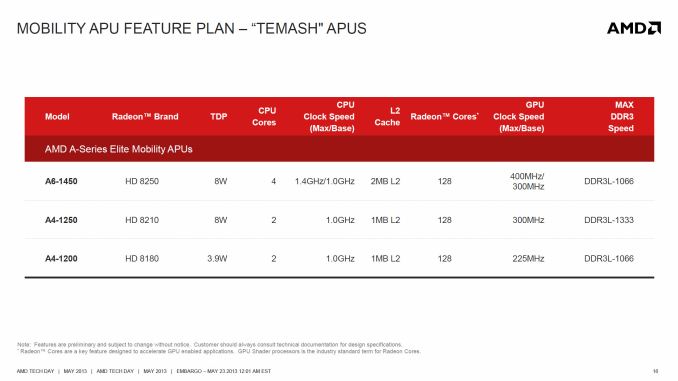

 Quote
Quote
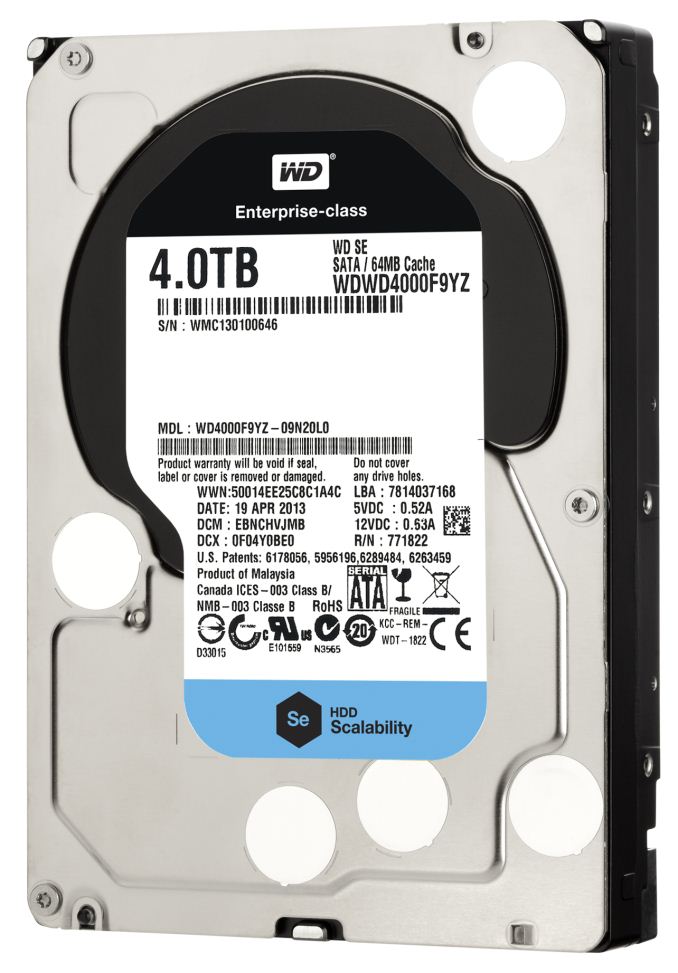
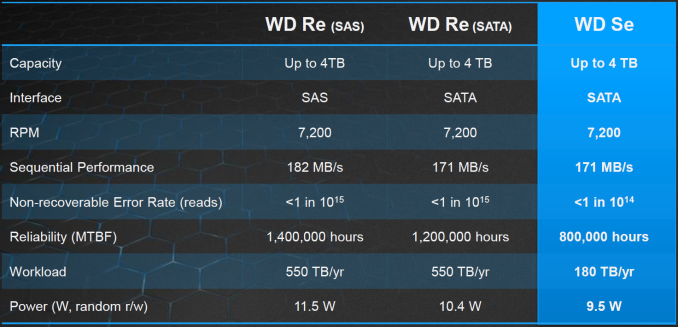
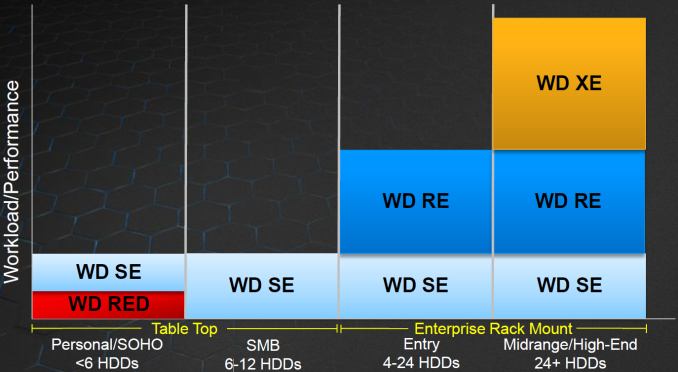
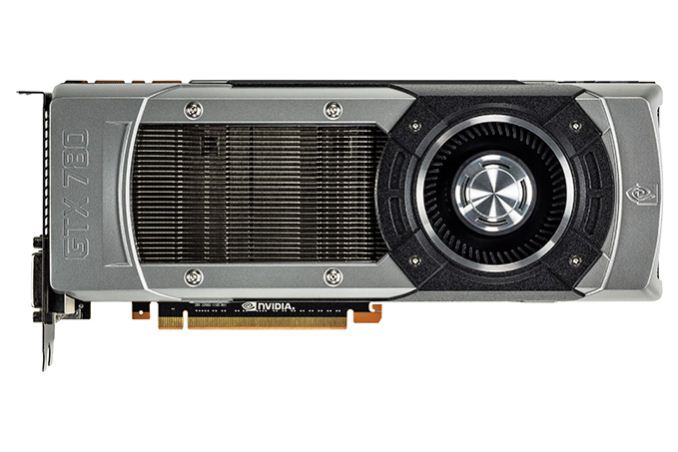
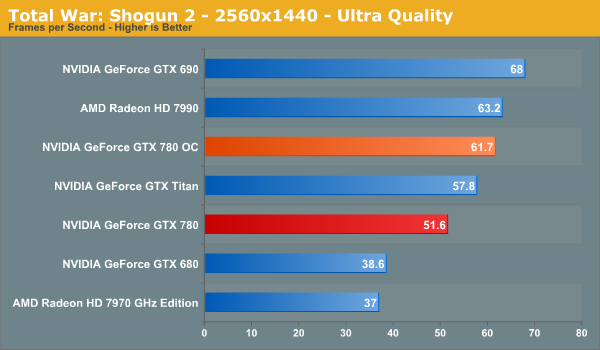
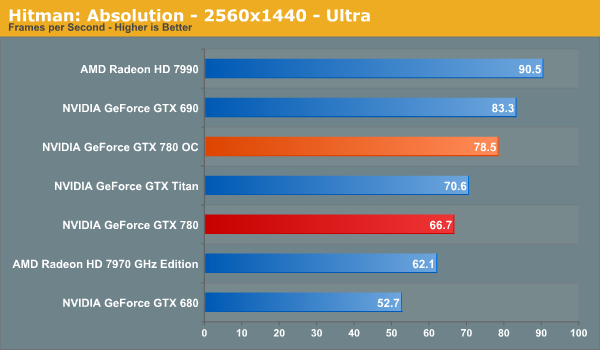

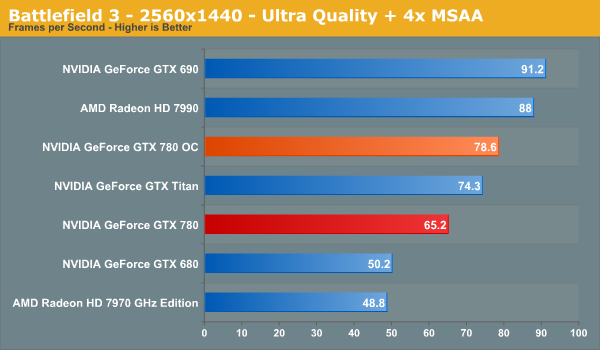

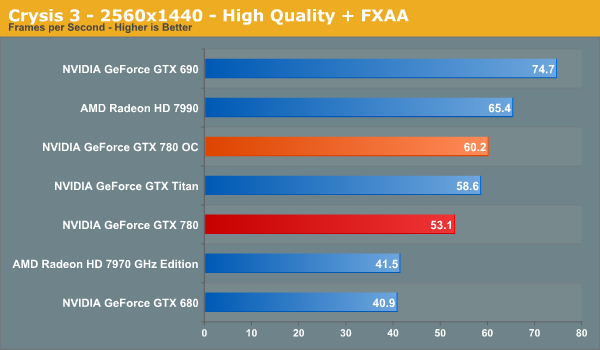
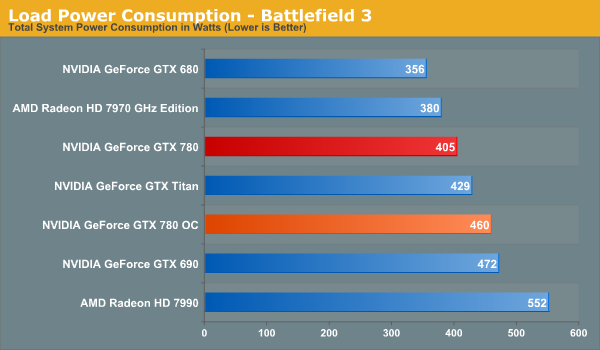
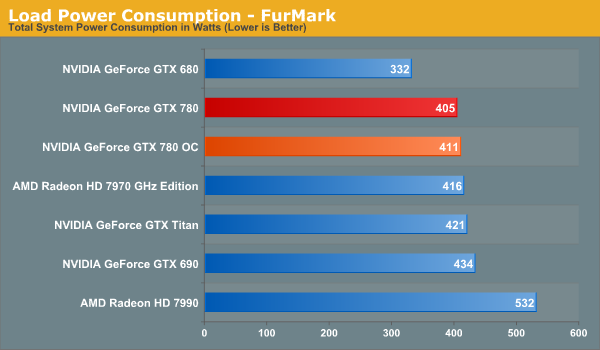
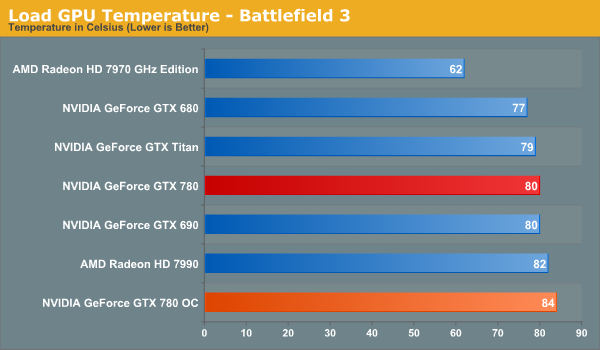
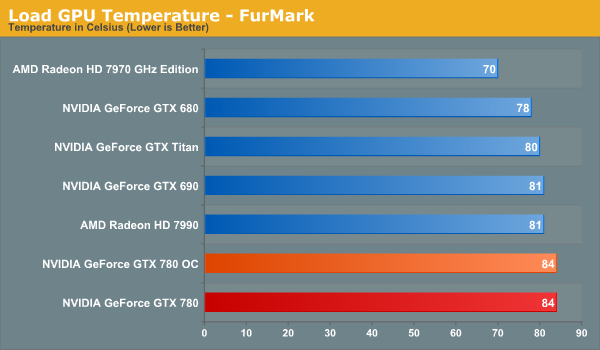

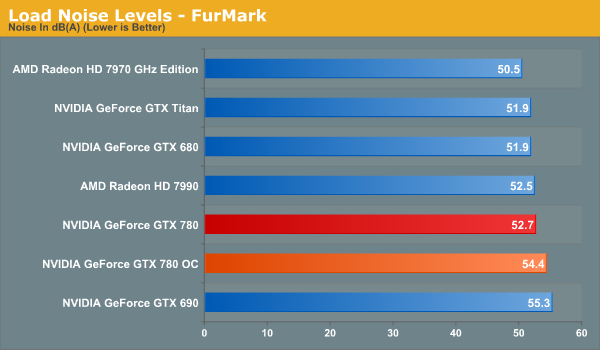
















Bookmarks